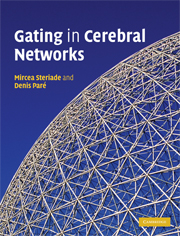Book contents
- Frontmatter
- Contents
- Preface
- Acknowledgements
- Chapter 1 Morphology and electroresponsive properties of thalamic neurons
- Chapter 2 Morphology and electroresponsive properties of neocortical cells
- Chapter 3 The amygdala
- Chapter 4 Rhinal and medial prefrontal cortices
- Chapter 5 Neuromodulation and state-dependent activities in forebrain neuronal circuits
- Chapter 6 Gating of signals in slow-wave sleep
- Chapter 7 Neuronal processes and cognitive functions in brain-active states of waking and REM sleep
- Chapter 8 Comparison of state-dependent activity patterns in the thalamocortical, hippocampal and amygdalocortical systems
- Chapter 9 Neuronal substrates of some mental disorders
- References
- Index
- Plate section
Chapter 3 - The amygdala
Published online by Cambridge University Press: 18 August 2009
- Frontmatter
- Contents
- Preface
- Acknowledgements
- Chapter 1 Morphology and electroresponsive properties of thalamic neurons
- Chapter 2 Morphology and electroresponsive properties of neocortical cells
- Chapter 3 The amygdala
- Chapter 4 Rhinal and medial prefrontal cortices
- Chapter 5 Neuromodulation and state-dependent activities in forebrain neuronal circuits
- Chapter 6 Gating of signals in slow-wave sleep
- Chapter 7 Neuronal processes and cognitive functions in brain-active states of waking and REM sleep
- Chapter 8 Comparison of state-dependent activity patterns in the thalamocortical, hippocampal and amygdalocortical systems
- Chapter 9 Neuronal substrates of some mental disorders
- References
- Index
- Plate section
Summary
This chapter describes the structure and connections of the amygdala, emphasizing three of its main components: the basolateral complex, the central nucleus and the intercalated cell masses. As we shall see in detail below, the basolateral complex is a cortex-like structure that receives most sensory inputs to the amygdala and projects to the central nucleus. In turn, the central nucleus contributes most amygdala projections to brainstem nuclei generating components of fear responses. However, because it would be would be maladaptive if all sensory inputs triggered fear, impulse traffic between the basolateral complex and central nucleus must be flexibly gated as a function of the particular combination of sensory inputs and environmental signals confronting the organism. This is the function of the intercalated cell masses, clusters of GABAergic neurons that receive glutamatergic inputs from the basolateral complex and project to central nucleus. This chapter will describe the connectivity and physiological properties underlying this process. Their system-level consequences will be considered later in this book (Chapter 9).
Is the amygdala a valid anatomical concept?
The amygdala is a nucleated structure located in the depth of the temporal lobe (Figures 3.1 and 3.2). Early anatomists divided the amygdala into three groups of nuclei (Johnston, 1923; Humphrey, 1936; Fox, 1940; Crosby & Humphrey, 1941): (1) the basolateral complex, comprised of the lateral, basolateral and basomedial nuclei; (2) the corticomedial group including the central, medial and cortical nuclei; and (3) an ill-defined anterior group including the anterior amygdaloid area, the nucleus of the lateral olfactory tract and the intercalated cell masses.
- Type
- Chapter
- Information
- Gating in Cerebral Networks , pp. 54 - 74Publisher: Cambridge University PressPrint publication year: 2007



